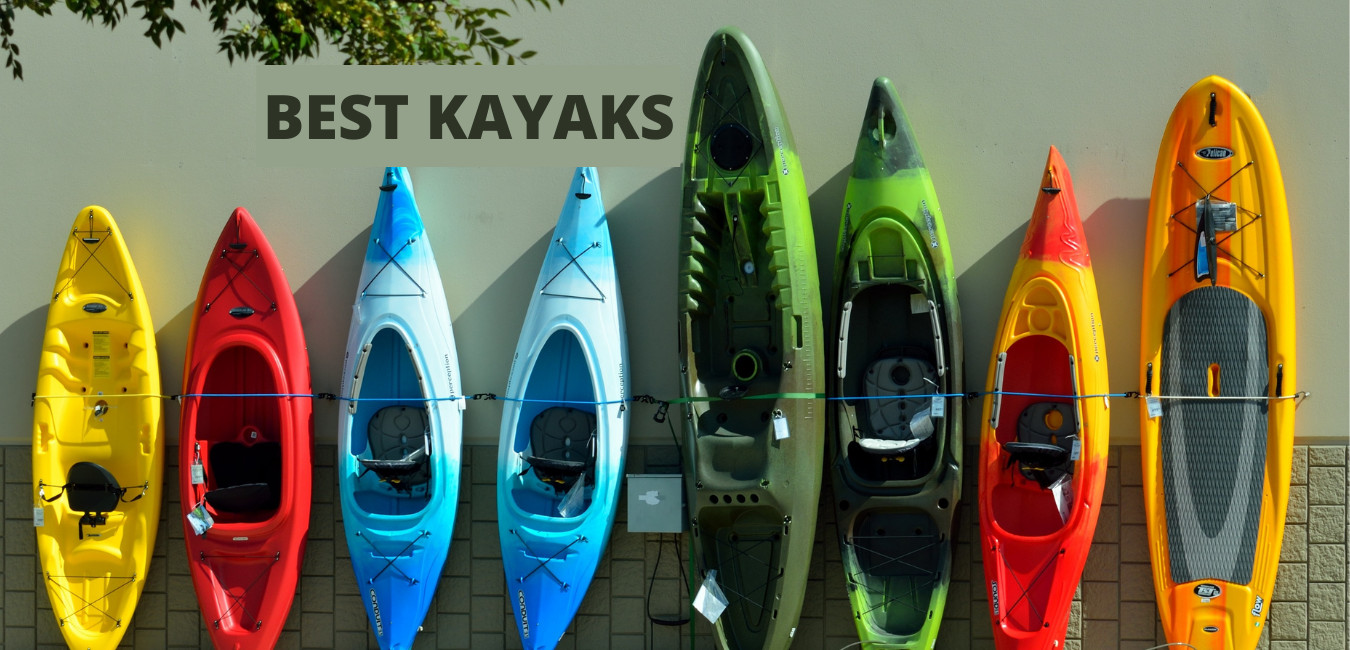Summertime brings with it a plethora of water-based activities. Perhaps you’ve had enough of splashing around in the pool or on inner tubes near the lakeshore with kayaks. Why don’t you try kayaking? Kayaking has grown in popularity over the last four decades as a result of a transition away from hard fiberglass hulls and toward today’s sturdy but cheap polyethylene hulls. Other modifications include a shift in hull design from the traditional “sit-inside” arrangement shown in photographs of Inuit and Aleut hunters to lighter, more stable sport watercraft designed for a variety of activities such as fishing.
The variety of kayak hulls and other features is enough to make a novice kayaker’s head spin. Which design is the most effective? Which one will last the longest on long excursions or across multiple seasons of use? We’re here to assist you in making your decision. We test products in this article to see which ones provide the best performance and value for your money. We speak with people who are knowledgeable about the products as well as those who use them to bring you this information.
Put your life jacket on and have your paddle ready. We want to provide you with the most relevant information so you can make an informed decision and acquire the best kayak for your needs.
TYPES OF KAYAKS
RECREATIONAL KAYAK:
These kayaks are the cheapest way to get into the sport. The cheapest are made of polyethylene, popularly known as “milk-bottle” plastic. It’s a denser, heavier material, which can make carrying larger recreational kayak challenging.
Beginners may easily paddle through shallow inland waterways in either sit-on-top or sit-in kayaks, with no concern for the kayak tipping over or “turtling.”
Because these kayak are frequently wide, they are difficult to tip over.
TOURING KAYAK:
This boat is considerably longer than a recreational kayak. The majority of the low-cost touring kayaks are composed of polyethylene, although the material is much thinner. Others use ABS plastic, which is lighter and has some UV resistance. However, because this sort of kayak is longer, the weight savings may not be obvious.
Touring kayak are often utilized in more difficult-to-navigate waters that necessitate more paddling skills. Before you can safely handle one, you may require further – and often extensive – training.
HYBRID KAYAK:
These kayaks are frequently far more specialized than an off-the-shelf kayak. These are custom-made, and the materials used are frequently one-of-a-kind. A hybrid kayak’s hull, for example, might be built of thermoformed plastic to conserve weight, or a kayaker might choose a tandem kayak with numerous seats in a canoe/kayak hybrid arrangement.
| IMAGE | Product NAME | Details | STORE | |
|---|---|---|---|---|
| Intex |
Intex

|
Intex Excursion Pro Kayak, Professional Series Inflatable Fishing Kayak, K2 |
|
Check On Amazon |
| Intex |
Intex

|
Intex Challenger Kayak Inflatable Set with Aluminum Oars |
|
Check On Amazon |
| Intex |
Intex

|
Explorer K2 Kayak, 2-Person Inflatable Kayak Set… |
|
Check On Amazon |
| Intex |
Intex

|
Intex Excursion Pro Kayak Series |
|
Check On Amazon |
| RCKAKS |
RCKAKS

|
RCKAKS Inflatable Stand Up Pink Paddle Board 10'6"x33"x6", Ultra-Light Board |
|
Check On Amazon |
SIT-IN VS. SIT-ON-TOP KAYAKS
Before considering price, color, or size, think about what kind of activity you’ll be doing and where you’ll be doing it when buying a kayak.
Kayakers who wish to paddle around near the shore of a tranquil lake for an hour or two require a boat that is very different from those who want to tackle Class 2 rapids or go out into the ocean. There are also others who wish to go on long camping vacations or engage in serious fishing. Every activity has a kayak, but they are divided into two types: sit-in kayaks and sit-on-top kayaks.
SIT-ON-TOP KAYAK:
On top of these kayak, the kayaker sits in a molded seat. This style is easier to get into than a sit-in kayak and is frequently more comfortable. Water can flow out or “self-bail” through scuppers in the hull. They also have dry storage hatches that are watertight. Some have an open compartment aft of the cockpit where objects like coolers can be easily accessed.
SIT-IN KAYAKS:
The kayaker sits inside the hull of these kayaks, as the name implies. A spray skirt, which wraps securely around the kayaker and above the cockpit, keeps water out of the hull. Some kayaks have storage bulkheads fore and aft, as well as watertight hatches for access to stowed objects.
- Hybrid Canoe/Kayak:
Hybrid kayaks’ wide-open cockpits allow for a lot more gear storage. It’s possible that these aren’t self-bailing. This type of kayak may be the most comfortable of all.
- Kayaks for Whitewater:
Sit-in kayak are smaller than touring or recreational kayaks, and the outside edges of the hull may be more rounded and the bottom flatter. In fast-moving rapids, these kayak are designed to be extremely agile.
- Sea Kayaks or Touring:
Sea sit-in kayaks are far longer than recreational sit-in kayaks. The increased length allows for improved control and tracking, as well as more cargo room. In rough water, spray skirts are necessary for sit-in sea kayaks.
SPECIALTY KAYAKS
FOLDING:
Folding kayaks aren’t as durable as hard-shell models, but they can come in handy if you’re hiking to a remote put-in place far from the parking lot. These also fit neatly into small flats or storage spaces.
INFLATABLE:
An inflatable kayak is another option to reduce space, whether it’s for storage or transportation. Inflatable kayaks in the lower price range are comparable in price and performance to low-end recreational kayaks. Some of the more expensive variants can be compared to touring kayaks.
FISHING:
Almost all of the various varieties of kayaks can be used for fishing, depending on your degree of experience, and some come with extra attachments for extras like rod holders. Rather than purchasing a separate fishing kayak, some kayakers, particularly those with open-cockpit recreational kayaks, may adapt their boats to conduct some casual fishing.
TANDEM:
Tandem two- or three-seat sit-in or sit-on-top kayaks are substantially longer and heavier than one-person kayaks. To move and steer this kayak properly, you’ll need some extra paddling practice.
KAYAK PRICES
The price of a kayak is determined by its manufacture, size, and purpose, and can range from under $300 to over $4,500.
Inflatable kayaks start around $300 and are comparable in price to low-end recreational kayak. Some of the more expensive models range from $1,000 to $2,000 in price.
Hybrid kayaks are more expensive than recreational kayak due to their specialist nature. The majority of them cost between $500 and $900.
Recreational begin at around $300, with some children’s variants costing under $100. Those who want to try kayaking but aren’t ready to invest in a more expensive model should consider purchasing a lower-end recreational kayak. Tandem kayaks start at around $600 and go higher from there. The typical cost of a folding kayak is considerably over $1,000.
Sea kayaks have the most diverse price range. Polyethylene kayaks range in price from $600 to $900 on the low end. Touring kayaks made of ABS plastic range in price from $1,500 to $3,000.
KAYAK ACCESSORIES
You should also purchase a sturdy paddle and a life jacket when purchasing a kayak. These are most likely the two most critical items you’ll require. The seller is not being aggressive if he or she advises them! Another option for carrying your kayak is to use a roof rack.
- Kayak-specific life jackets are more flexible, with thinner material at the shoulders to allow you to move your arms more freely.
- Kayaking paddles are lightweight, weighing as little as 24 ounces, requiring less effort to propel your kayak across the water. Lighter paddles are, of course, more expensive than heavier paddles.
- For leisure and whitewater kayak, a roof rack is a popular option. Larger sea kayaks may require a trailer to be loaded.
TIPS FOR YOUR SAFETY:
- When your kayak isn’t in use, keep it protected from the sun. Even a kayak with a UV-resistant hull needs to be kept out of the sun while not in use. Protective sprays that decrease hull damage from UV rays are available but check with the manufacturer to ensure that the spray is suitable for your model. Some kayaks have UV protection built-in.
- When your kayak is not in use, keep it dry. Place it hull-side up on a raised surface – a trailer rack or several stacks of bricks spaced evenly along the hull – with a weather-resistant buffer between the rack or bricks and the hull contact areas to prevent scratches. Cover the hull with a tarp, but don’t let the tarp touch the hull. This can cause the hull to be damaged by trapping moisture between the hull and the tarp.
- Keep your kayak from warping by storing it properly. Make sure the weight is uniformly distributed, whether it’s suspended from straps or sitting on a rack. With the correct connection points, shorter recreational kayaks can be suspended vertically on the wall.
CONCLUSION:
If you’re hunting for a fun, inexpensive sport to try this summer, there’s no better choice than kayaking. It’s a great way to get out on the water and enjoy the outdoors. Best of all, it’s easy to find other like-minded enthusiasts. Whether you’re fishing for walleye or just relaxing on a slow float down the river, kayaking is a fantastic summer activity.




